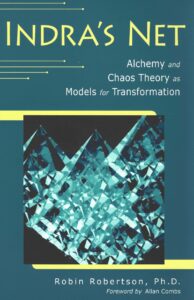Indra’s Net – Alchemy and Chaos Theory as Models for Transformation
By Robert Robertson, Ph.D., Foreword by Allan Combs.
182 Pages | First Quest Edition 2009 | Softcover | Quest Books, U.S.A. | ISBN: 9780835608626.
' Somewhere in the celestial palace of the dancing god Indra, there hangs a fabulous net, that spreads out boundlessly over the cosmos in every direction. The divine craftsman has so cleverly fashioned this net that at every knot there hangs a dazzling jewel, each one so brilliantly polished, that it reflects all the others. As Above, so Below . . . '
This image of Indra's net from a Buddhist Sutra symbolizes the Mystery, that, through our own transformation, each of us is united with everyone and everything else. Author Robin Robertson finds parallel models in ancient Alchemy, which tried to change base metal into gold, and modern chaos theory, which posits that tiny initial changes can have huge and unexpected outcomes - as a butterfly in Brazil might cause a tornado in Texas. Robinson lucidly shows how these two systems reveal the pattern of inner development in any spiritual tradition. No matter what one's particular calling, these surprising insights can enrich and accelerate the transformative stages of any spiritual seeker.
From Chapter 6 - 'The Philosopher's Stone':
" Central to this book is the understanding that the Opus is within us as much as it is without. As I mentioned in the Introduction, Buddhist philosophy captures this relationship between the world and the psyche through the image of Indra's net: a vast necklace of shining jewels, all interconnected. It is told thus in the Avatamsaka Sutra:
Far away in the heavenly abode of the great God Indra, there is a wonderful net, which has been hung by some cunning artificer in such a manner that it stretches out infinitely in all directions. In accordance with the extravagant tastes of deities, the artificer has hung a single glittering jewel in each 'eye' of the net, and since the net itself is infinite in dimension, the jewels are infinite in number. There hang the Jewels, glittering like stars in the first magnitude, a wonderful sight to behold. If we now arbitrarily select one of these jewels for inspection and look closely at it, we will discover that in its polished surface there are reflected all the other jewels in the net, infinite in number. Not only that, but each of the jewels reflected in this one jewel is also reflecting all the other jewels, so that there is an infinite reflecting process ocurring. "
 Bezig met bijwerken...
Bezig met bijwerken...